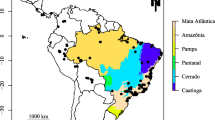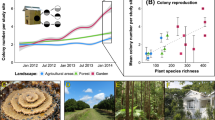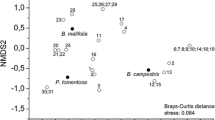Abstract
Biodiverse environments provide a variety of resources that can be exploited by consumers. While many studies revealed a positive correlation between biodiversity and consumer biomass and richness, only few studies have investigated how resource diversity affects single consumers. To better understand whether a single consumer species benefits from diverse resources, we tested how the protective function of a defensive plant resource (i.e. resin exploited by social bees) varied among different sources and target organisms (predators, parasites and pathogens). To assess synergistic effects, resins from different plant genera were tested separately and in combination. We found that resin diversity is beneficial for bees, with its functional properties depending on the target organisms, type and composition of resin. Different resins showed different effects, and mixtures were more effective than some of the single resins (functional complementarity). We conclude that resins of different plant species target different organisms and act synergistically where combined. Bees that rely on resin for protection benefit more when they have access to diverse resin sources. Loss of biodiversity may in turn destabilize consumer populations due to restricted access to a variety of resources.


Similar content being viewed by others
References
Alaux C, Ducloz F, Crauser D, Le Conte Y (2010) Diet effects on honeybee immunocompetence. Biol Lett 6:562–565
Armbruster WS (1984) The role of resin in angiosperm pollination—ecological and chemical considerations. Am J Bot 71:1149–1160
Balvanera P, et al. (2006) Quantifying the evidence for biodiversity effects on ecosystem functioning and services. Ecol Lett 9:1146–1156
Bankova VS, de Castro SL, Marcucci MC (2000) Propolis: recent advances in chemistry and plant origin. Apidologie 31:3–15
Behmer ST (2009) Insect herbivore nutrient regulation. Annu Rev Entomol 54:165–187
Blüthgen N, Klein AM (2011) Functional complementarity and specialisation: why biodiversity is important in plant-pollinator interactions. Basic Appl Ecol 12:282–291
Brittain C, Kremen C, Klein AM (2013) Biodiversity buffers pollination in changing environmental conditions. Glob Change Biol 19:540–547
Burwell CJ (2007) Ants of Brisbane. Queensland Museum, Brisbane
Cardinale BJ, Harvey CT, Gross K, Ives AR (2003) Biodiversity and biocontrol: emergent impacts of a multi-enemy assemblage on pest suppression and crop yield in an agroecosystem. Ecol Lett 6:857–865
Chou T-C (2010) Drug combination studies and their synergy quantification using the Chou-Talalay method. Cancer Res 70:440–446
Cushnie TPT, Lamb AJ (2011) Recent advances in understanding the antibacterial properties of flavonoids. Int J Antimicrob Agents 38:99–107
Damiani N, Fernández NJ, Maldonado LM, Alvarez AR, Eguaras MJ, Marcangeli JA (2010) Bioactivity of propolis from different geographical origins on Varroa destructor (Acari: Varroidae). Parasitol Res 107:31–37
De Deyn GB, Raaijmakers CE, van Ruijven J, Berendse F, van der Putten WH (2004) Plant species identity and diversity effects on different trophic levels of nematodes in the soil food web. Oikos 106:576–586
Dollin AE, Dollin LJ, Sakagami SF (1997) Australian stingless bees of the genus Trigona (Hymenoptera: Apidae). Invertebr Taxon 11:861–896
Duangphakdee O, Koeniger N, Koeniger G, Wongsiri S, Deowanish S (2005) Reinforcing a barrier—a specific social defense of the dwarf honeybee (Apis florea) released by the weaver ant (Oecophylla smaragdina). Apidologie 36:505–511
Duangphakdee O, Koeniger N, Deowanish S, Hepburn HR, Wongsiri S (2009) Ant repellent resins of honeybees and stingless bees. Insect Soc
Duffy JE, Carinale BJ, France KE, McIntyre PB, Thebault E, Loreau M (2007) The functional role of biodiversity in ecosystems: incorporating trophic complexity. Ecol Lett 10:522–538
Eckhardt M, Haider M, Dorn S, Müller A (2014) Pollen mixing in pollen generalist solitary bees: a possible strategy to complement or mitigate unfavourable pollen properties? J Anim Ecol 83:588–597
Finke DL, Snyder WE (2008) Niche partitioning increases resource exploitation by diverse communities. Science 321:1488–1490
Gamfeldt L, Hillebrand H, Jonsson PR (2005) Species richness changes across two trophic levels simultaneously affect prey and consumer biomass. Ecol Lett 8:696–703
Garedew A, Lamprecht I, Schmolz E, Schricker B (2002) The varroacidal action of propolis: a laboratory assay. Apidologie 33:41–50
Garedew A, Schmolz E, Lamprecht I (2004) Effect of the bee glue (propolis) on the calorimetrically measured metabolic rate and metamorphosis of the greater wax moth Galleria mellonella. Thermochim Acta 413:63–72
Gershenzon J, Dudareva N (2007) The function of terpene natural products in the natural world. Nat Chem Biol 3:408–414
Ghisalberti EL (1996) Bioactive acylphloroglucinol derivatives from Eucalyptus species. Phytochemistry 41:7–22
Greco MK, Hoffmann D, Dollin A, Duncan M, Spooner-Hart R, Neumann P (2010) The alternative pharao approach: stingless bees mummify beetle parasites alive. Naturwissenschaften 97:319–323
Hägele BF, Rowell-Rahier M (1999) Dietary mixing in three generalist herbivores: nutrient complementation or toxin dilution? Oecologia 119:521–533
Halcroft M, Spooner-Hart R, Neumann P (2011) Behavioral defense strategies of the stingless bee, Austroplebeia australis, against the small hive beetle, Aethina tumida. Insect Soc 58:245–253
Hättenschwiler S, Tiunov AV, Scheu S (2005) Biodiversity and litter decomposition in terrestrial ecosystems. Annu Rev Ecol Evol Syst 36:191–218
Höcherl N, Siede R, Illies I, Gätschenberger H, Tautz J (2012) Evaluation of the nutritive value of maize for honey bees. J Insect Physiol 58:278–285
Hooper DU (1998) The role of complementarity and competition in ecosystem responses to variation in plant diversity. Ecology 79:704–719
Ives RA, Cardinale BJ, Snyder WE (2005) A synthesis of subdisciplines: predator–prey interactions, and biodiversity and ecosystem functioning. Ecol Lett 8:102–116
Junker RR, Blüthgen N (2008) Floral scents repel potentially nectar-thieving ants. Evol Ecol Res 10:295–308
Junker RR, Blüthgen N (2010) Floral scents repel facultative flower visitors, but attract obligate ones. Ann Bot. doi:10.1093/aob/mcq1045
Junker RR, Gershenzon J, Unsicker SB (2011) Floral odour bouquet loses its ant repellent properties after inhibition of terpene biosynthesis. J Chem Ecol 37:1323–1331
Kujumgiev A, Tsvetkova I, Serkedjieva Y, Bankova V, Christov R, Popov S (1999) Antibacterial, antifungal and antiviral activity of propolis of different geographic origin. J Ethnopharmacol 64:235–240
Langenheim JH (2003) Plant resins: chemistry, evolution, ecology and ethnobotany. Timber Press, Portland
Leonhardt SD, Blüthgen N (2009) A sticky affair: resin collection by Bornean stingless bees. Biotropica 41:730–736
Leonhardt SD, Blüthgen N, Schmitt T (2009) Smelling like resin: terpenoids account for species-specific cuticular profiles in Southeast-Asian stingless bees. Insect Soc 56:157–170
Leonhardt SD, Jung L-M, Schmitt T, Blüthgen N (2010) Terpenoids tame aggressors: role of chemicals in stingless bee communal nesting. Behav Ecol Sociobiol 64:1415–1423
Leonhardt SD, Schmitt T, Blüthgen N (2011a) Tree resin composition, collection behavior and selective filters shape chemical profiles of tropical bees (Apidae: Meliponini). PLoS One 6:e23445
Leonhardt SD, Wallace HM, Schmitt T (2011b) The cuticular profiles of Australian stingless bees are shaped by resin of the eucalypt tree Corymbia torelliana. Austral Ecol 36:537–543
Leonhardt SD, Rasmussen C, Schmitt T (2013) Genes vs. environment: geography and phylogenetic relationships shape the chemical profiles of stingless bees on a global scale. Proc R Soc Lond B 280: 20130680
Litman JR, Danforth BN, Eardley CD, Praz CJ (2011) Why do leafcutter bees cut leaves? New insights into the early evolution of bees. Proc R Soc Lond B 278:3593–3600
Loreau M, Hector A (2001) Partitioning selection and complementarity in biodiversity experiments. Nature 412:72–76
Loreau M, et al. (2001) Ecology—biodiversity and ecosystem functioning: current knowledge and future challenges. Science 294:804–808
Massaro CF, et al. (2014) Anti-staphylococcal activity of C-methyl flavanones from propolis of Australian stingless bees (Tetragonula carbonaria) and fruit resins of Corymbia torelliana (Myrtaceae). Fitoterapia 95:247–257
Michener CD (2007) The bees of the world. John Hopkins University Press, Baltimore
Mihai CM, Mărghitaş LA, Dezmirean DS, Chirilă F, Moritza RFA, Schlüns H (2012) Interactions among flavonoids of propolis affect antibacterial activity against the honeybee pathogen Paenibacillus larvae. J Invertebr Pathol 110:68–72
Nicodemo D, Malheiros EB, De Jong D, Couto RHN (2013) Increased brood viability and longer lifespan of honeybees selected for propolis production. Apidologie 45:269–275
Petchey OL (2003) Integrating methods that investigate how complementarity influences ecosystem functioning. Oikos 101:323–330
Popova MP, et al. (2007) Chemical characteristics of poplar type propolis of different geographic origin. Apidologie 38:306–311
R Development Core Team (2013) R: a language and environment for statistical computing http://www.R-project.org. R Foundation for Statistical Computing, Vienna
Rosenfeld JS (2002) Functional redundancy in ecology and conservation. Oikos 98:156–162
Roubik DW (1989) Ecology and natural history of tropical bees. Cambridge University Press, New York
Roubik DW (2006) Stingless bee nesting biology. Apidologie 37:124–143
Seeley TD, Seeley RH, Akratanakul P (1982) Colony defense strategies of the honeybees in Thailand. Ecol Monogr 52:43–63
Siemann E (1998) Experimental tests of effects of plant productivity and diversity on grassland arthropod diversity. Ecology 79:2057–2070
Simone M, Evans JD, Spivak M (2009) Resin collection and social immunity in honey bees. Evolution 63:3016–3022
Simone-Finstrom M, Spivak M (2010) Propolis and bee health: the natural history and significance of resin use by honey bees. Apidologie 41:295–311
Simpson SJ, Raubenheimer D (2012) The nature of nutrition: a unifying framework from animal adaptation to human obesity. Princeton University Press, Princeton
Tilman D (1999) The ecological consequences of changes in biodiversity: a search for general principles. Ecology 80:1455–1474
Unsicker SB, Oswald A, Köhler G, Weisser WW (2008) Complementarity effects through dietary mixing enhance the performance of a generalist insect herbivore. Oecologia 156:313–324
Walker K (2010) “Austroplebeia australis” sugarbag bee (Austroplebeia australis). PaDIL. http://www.padil.gov.au
Wallace HM, Lee DJ (2010) Resin-foraging by colonies of Trigona sapiens and T. hockingsi (Hymenoptera: Apidae, Meliponini) and consequent seed dispersal of Corymbia torelliana (Myrtaceae). Apidologie 41:428–435
Wallace HM, Trueman SJ (1995) Dispersal of Eucalyptus torelliana seeds by the resin-collecting stingless bee, Trigona carbonaria. Oecologia 104:12–16
Wardle DA, Nicholson KS (1996) Synergistic effects of grassland plant species on soil microbial biomass and activity: implications for ecosystem-level effects of enriched plant diversity. Funct Ecol 10:410–416
Wenzel F (2011) Smell and repel: resin based defense mechanisms and interactions between Australian ants and stingless bees. Master's degree, Theodor-Boveri-Institut für Biowissenschaften, University of Würzburg, Würzburg
Wilson MB, Spivak M, Hegeman AD, Rendahl A, Cohen JD (2013) Metabolomics reveals the origins of antimicrobial plant resins collected by honey bees. PLoS One 8:e77512
Wohl DL, Arora S, Gladstone JR (2004) Functional redundancy supports biodiversity and ecosystem function in a closed and constant environment. Ecology 85:1534–1540
Yachi S, Loreau M (2007) Does complementary resource use enhance ecosystem functioning? A model of light competition in plant communities. Ecol Lett 10:54–62
Acknowledgments
We thank Anna Baumann and Benjamin Kaluza for help with data collection and Alexandra-Maria Klein for helpful advice on the manuscript and the experimental design. We are also very grateful for the helpful comments of two anonymous reviewers. Funding for S. D. L. and N. D. was provided by the Deutsche Forschungs-Gemeinschaft (project LE 2750/1-1). N. D. is further funded by a doctoral fellowship provided by Leuphana University, Lüneburg, Germany.
Conflict of interest
The authors declare that they have no conflict of interest.
Author information
Authors and Affiliations
Corresponding author
Additional information
Communicated by Richard Karban.
Rights and permissions
About this article
Cite this article
Drescher, N., Wallace, H.M., Katouli, M. et al. Diversity matters: how bees benefit from different resin sources. Oecologia 176, 943–953 (2014). https://doi.org/10.1007/s00442-014-3070-z
Received:
Accepted:
Published:
Issue Date:
DOI: https://doi.org/10.1007/s00442-014-3070-z




